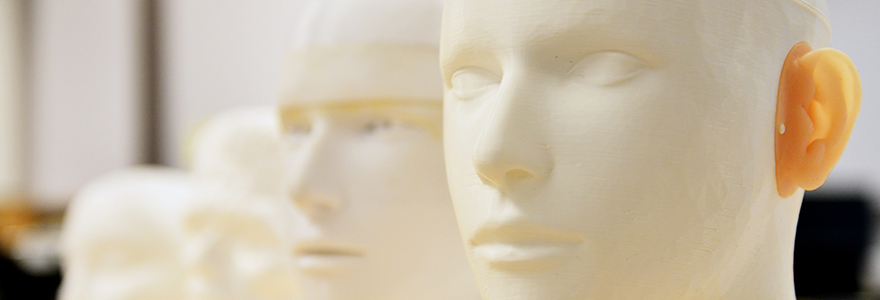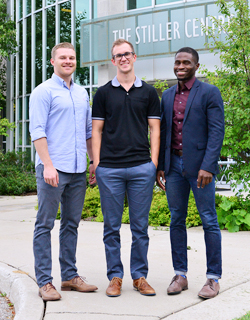Biomedical engineering grad launches simulation technology startup to improve hearing health care

By Emily Leighton, MA'13
The plastic mannequin head in Robert Koch’s carry-on luggage wasn’t noticeable to other airline passengers, but it did cause a brief conundrum in the security line at Detroit Metro Airport.
On his way to an audiology conference in Lake Tahoe, Koch, BESc’16, MESc’18, knew the mannequin would raise a few eyebrows. “I warned the security officers before I put it through the x-ray scanner,” he said with a laugh.
The recent alumnus leads AHead Simulations, a startup company focused on simulation training in the field of audiology. Based at Western Research Parks, Koch founded the company last year to commercialize a head and ear simulator he first developed as an undergraduate student. With colleagues and former classmates John Iyaniwura, MESc’17, Lead Software Developer (right), and Justin Laing, BESc’15, MESc’17, Lead Hardware Developer (left), Koch is applying the training he received at Schulich Medicine & Dentistry to improve hearing health care.
With colleagues and former classmates John Iyaniwura, MESc’17, Lead Software Developer (right), and Justin Laing, BESc’15, MESc’17, Lead Hardware Developer (left), Koch is applying the training he received at Schulich Medicine & Dentistry to improve hearing health care.
The first clinical challenge the company is tackling is a procedure called probe tube placement.
In the audiology environment, best practices dictate that a clinician must verify if prescribed hearing aids are operating effectively. This step is completed by inserting a thin, flexible probe tube into a patient’s ear canal within five millimetres of the eardrum, to ensure the device is properly correcting the patient’s hearing loss.
“If the probe isn’t properly placed, the clinician cannot verify that the hearing aid is delivering the proper amplification needed for that specific patient,” explained Koch.
But data shows that best practices for the procedure are not being followed in the clinical setting.
One explanation for this discrepancy is the lack of effective training. And this is where medical simulation technology can play a valuable role.
AHead Simulations’ simulator consists of a 3D-printed mannequin head with realistic silicone ears – produced from CT scans to represent an accurate anatomical model. A small camera is mounted inside the mannequin head, facing the ear canal.
“An important part of our simulator is the transparent ear canal,” explained Koch. “Our camera system can provide real-time feedback to any objects inside the ear canal.”
The simulator gives audiologists and hearing instrument specialists an opportunity to practise probe tube placement in a safe, stress-free environment before affecting the care of patients.
“For a novice clinician, it's difficult to look inside someone's ear and estimate the depth of the probe in the ear canal,” he said. “Getting real-time feedback in a practice scenario is incredibly useful.”
Koch’s collection of 3D-printed and silicone ear models, dubbed the “ear graveyard,” portrays a visual evolution of a simulator he’s been working on since his undergraduate days with Western's Faculty of Engineering.
The research began as a capstone project during the final year of his electrical engineering degree. Tasked with applying his learning to address a specific problem, Koch came across a promising project through Hanif Ladak, PhD, professor in Medical Biophysics.
“I was interested in getting into the biomedical space,” Koch said. “And Hanif had really interesting ideas about how simulation technology could be used for training within audiology."
Working closely with Ladak and the National Centre for Audiology (NCA), Koch took the project forward to a master’s degree in biomedical engineering, completing two more years of extensive development and validation studies with an early prototype.
Recognizing the business potential, Koch completed a technology commercialization course at Western. And with the help of WORLDiscoveries, he applied for BURST funding from Tech Alliance, a regional innovation centre providing education and resources for entrepreneurs and existing businesses in London.
After receiving the funding in early 2018, AHead Simulations incorporated in March. Since then, the team has been developing and testing a more sophisticated simulator model.
This fall, the company is starting an early adopters program with several test sites across the country, and is aiming for an official product launch in the new year.
By designing the mannequin head with simplicity and flexibility in mind, the AHead Simulations team hopes to incorporate additional training capabilities for a range of audiology procedures in the near future.
“Probe tube placement was a good place to start, but there are lots of places we can go,” Koch said. “With a modular head and ear simulator, we can design something quite minimal and have a big effect on how training is conducted within audiology."
For the 23-year-old, the potential for improved patient care serves as motivation to keep pushing forward. “Sound is a crucial part of people’s lives and hearing loss can be very isolating,” he said. “For a project we started just a few years ago to have an actual impact in the clinic is an incredible feeling.”


